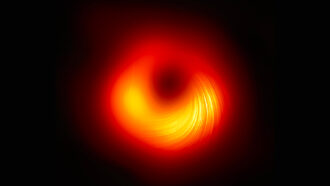Machine Learning Enhances Clarity of First Black Hole Snapshot.

If the initial portrayal of a black hole resembled a blurry donut, the latest rendition appears more like a slim onion ring.
Leveraging a technique rooted in machine learning, researchers have enhanced the image of the supermassive black hole nestled within the M87 galaxy. The refined portrait boasts a slimmer halo of shimmering gas compared to the previously captured imagery.
The Event Horizon Telescope team shared the first-ever image of M87’s black hole in 2019, which revealed an orange ring of whirling gas enveloping the dark giant. The fresh snapshot depicts a ring that is half as thick as the original, despite relying on the same data. The Astrophysical Journal Letters reported the updated findings on April 13.
The Event Horizon Telescope uses interconnected telescopes spanning the globe for data collection. But this methodology can result in data gaps. Astrophysicist Lia Medeiros of the Institute for Advanced Study in Princeton, N.J., explained that “since we can’t just cover the entire Earth in telescopes, what that means is that there is some missing information. We need to have an algorithm that can fill in those gaps.”
To fill those gaps, previous analyses utilized specific assumptions, such as conjuring up a smoother image. In contrast, the newer approach employs machine learning to complete data gaps using more than 30,000 simulated images showing matter engulfing a black hole. This yields an image that is much sharper than before.
In the future, this technique may facilitate a better understanding of the black hole’s mass and enable enhanced assessments of gravity in addition to other black hole physics research.
Our objective is to deliver precise and engaging scientific news content to the public. This mission is critical now more than ever.
As a nonprofit news outlet, we rely on your support to make this possible.
Your contributions help us in keeping our content available to the next generation of engineers and scientists. You can invest in quality scientific journalism by donating today.




